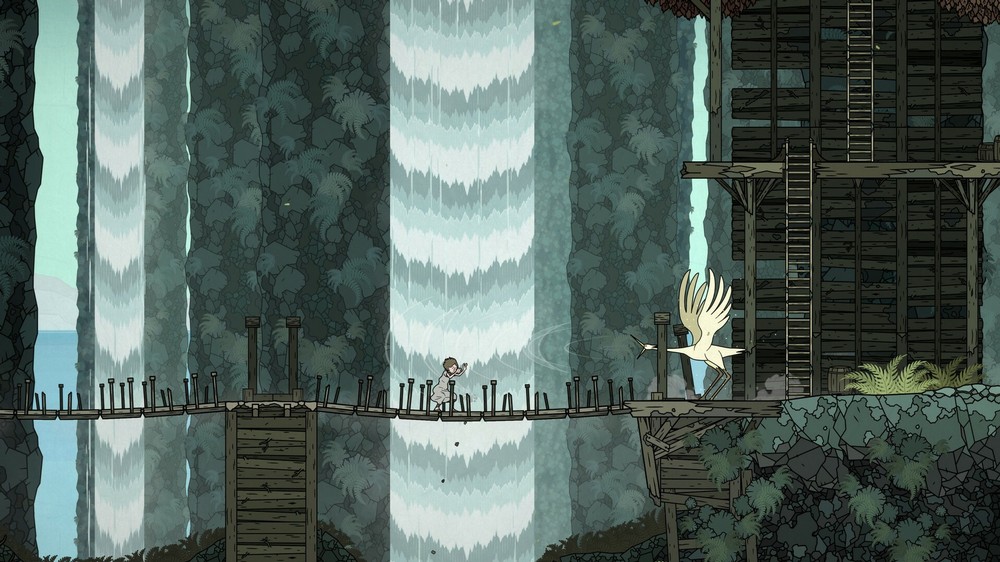In terms of media plots, man VS narrator is not explored all that often within video games. It’s not quite the story of man vs. God, as instead of an omnipresent being, you’re going off against someone who is just trying to tell and direct you where to go. Of course, the main game that has this claim is The Stanley Parable, with you getting the chance to derail the narrator’s story. Here, it’s a more serious take on this idea. Developed by Empty Head Games, they ensured that their experiences in Cuba were also a core aspect of this game; Saviorless. Incorporating what they felt and saw while in the country, I can only imagine that those from Cuba or who heavily love the country would love this game all the more. While Saviorless is still a decent time and well deserved the title of being the first indie game created entirely in Cuba, it does feel like this story is a couple of chapters too short.
The character you will be playing is Antar, an eager child who wants to go to the Smiling Islands, a land that promises the chance to become an all-powerful savior. Following a radiant heron, Antar follows it in hopes of achieving his goal. However, this is just a story being told by a narrator called Tobias, using it to teach his children Len and Arimbo about what it means to be a narrator, namely never let the protagonist win because if their quest is done; they are done as well. When Tobias falls asleep and Len and Arimbo switch over to tell a story about a new character called Nento who is a savage fighter, the threads of all these stories start to get intertwined as they all try to fight for their ending. However, there can only be one side that could win in the end…
Developed by Empty Head Games, Saviorless features right off the bat a lovely hand-drawn animation aesthetic. The way the characters flow and move around the environment all look majestic and impressive. The backgrounds also can look nice and be majestic throughout the multiple worlds that the story travels through. That said, while the backgrounds do look nice, they also look the same through all the levels thanks to the same brown and gray colors being used. While some select standouts like the hidden final area or the third world have a bright color palette, a good two-thirds of the game relies on the brown and gray colors.
On the one hand, it’s fitting since the world’s pretty much in complete disarray, with the Antar piecing together what could have possibly happened here. However, on the other hand, in terms of making them distinct, it does fail and make them all blend in, making them harder to distinguish. They do have some different structures and puzzle types in them, but when looking at levels through snapshots, it can be hard to tell which screenshot belongs to which level.
The music also follows this pattern of being good but blending into the other levels too much. The game wants to have an atmosphere dripping from its pores, and here it manages to do that by excessive use of the piano. It manages to help each song feel alive and help the player get more immersed in the world and all the different levels. However, each level keeps focusing on the piano for its music to dominate the piece, which makes it hard to determine which song goes to which level. If the graphics made it hard to choose which level was which, then the music is close to impossible to separate and determine which levels they belonged in. It’s not bad music at all, but it’s a soundtrack that blends all the songs way too easily.
The real meat and potatoes of this game is the puzzle platforming gameplay, and here, if you’re playing the game with the idea of just going through point A to point B, it’s an easy ride. As Antar, you can only run, jump, climb, and use your hands to pick up objects, push stuff around, and pull switches. This isn’t a problem as most puzzle games have such a limited move set. The problem here is the puzzles are not only simple, but they take a while to do even when you know the solution. It can end up making the levels feel dragged out and feel like your time is just wasted.
However, this isn’t the only playstyle you’ll be using. Throughout some portions of the game, you will switch over to playing as either a savior or as Nento. They both focus more on combat, jumping around enemies and attacking others than doing puzzles. While Nento’s sections are just simple hacks and slashes that can boil down to one-button gameplay, the Savior’s section is capable of having some more unique ideas. You have a time limit that can be extended by attacking objects and enemies and can jump and dash around. However, you instantly die if the time limit is up, so you need to reach the end of the section to turn back into Antar. The game can pick up more and more as the levels go on, but it feels like it stops just as soon as it gets really interesting.
The real challenge is going to be coming from collecting all the paper scraps. Throughout the world, there will be a chronicler writing down your story called Dasein. After collecting all the page scraps to form a full page in each level, you can trade them in for an item from the chest next to him. These items are all needed for the true ending, so it is in your best interest to get all the pages. These page scraps are where the real challenging puzzles come from. They often have you closely examine the levels and see what you can interact with, be it by crawling somewhere you didn’t realize you could go to or using a switch multiple times. It’s not as big or impressive as other platforming puzzle games, like Braid or Limbo, but it’s still able to get you to focus and think more about the game.
The main sticking point for many would be the length. An average player wanting to just beat the game could get it all done within two hours, with the time doubling at best if you’re trying to hunt down all the pages and beat the secret hidden level, but that’s it. Back when the Indiegogo campaign launched, the game only had enough funds to meet its baseline goal of $10,000. There were plans and screenshots for the game to have a much bigger and open scope, with many different characters that you would be playing as. This isn’t a case of the team simply taking the money and running after releasing a sloppy game; they’re trying to make the most out of every penny they had.
Don’t take these comments to be discouraging, however. The game is still a pleasant time, and well worth the $13 price tag. The gameplay is still decent even if the puzzles are a bit too simple at times, the narrative is the strongest aspect of the game, giving you enough unique and fun narrative themes that make you want to explore the world and see what’s going on, and despite being too similar at times, the graphics and audio are still engaging to see in motion and listen to. There is care and love poured into this game, from the animation to the respect for Cuban culture. It may not be a book worth reading again after one go, but one read may be more than enough for this charming story to take hold of you.















